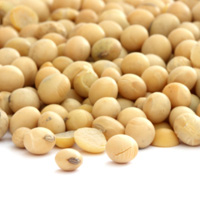Seven salads that will make you eager to eat your veggies.
Tag: Diet
Water Works
Water provides true refreshment for the thirsty, but most people don’t know that it also plays a vital role in all bodily processes. Unfortunately, most people don’t drink enough water, perhaps because they don’t realize just how important it is. The fact is, not drinking enough water affects every aspect of your body, right out to your skin.
5 Easy Ways to Sneak Soy Into Your Diet
The first written record of the soybean was found in Chinese books dating back to 2838 B.C. It has been the primary protein source for people in Asia for centuries. Americans have used it for little more than oil and livestock feed. But things have changed.
The humble soybean has captured the attention of health-conscious consumers everywhere–with good reason. Research has shown that incorporating soy protein into the diet provides numerous health benefits, including reducing the risk of heart disease and reducing the levels of LDL, or “bad cholesterol,” in the bloodstream. The United States Food and Drug Administration (FDA) recently issued a recommendation for consumers to integrate 25 grams of soy protein per day into their diets.
Six Simple Steps to Avoid Food-borne Illness
If you are a vegetarian, the thought of having a food-borne illness probably never crosses your mind. After all, everyone knows that E. coli makes its home in raw beef, and Salmonella breeds rapidly in undercooked chicken or pork.
Well, it’s time to rethink your past beliefs about food-borne illness, as fresh fruits, vegetables, eggs, lentils, and dairy products can also play host to a variety of deleterious bacteria, including E. coli and Salmonella. In fact, some of the most common carriers of food-borne germs include basil, cantaloupe, lettuce, potatoes, raspberries, scallions, strawberries, and tomatoes.
According to the Centers for Disease Control and Prevention (CDC), food-borne diseases cause an estimated 76 million illnesses, 325,000 hospitalizations, and 5,200 deaths in the United States each year. Not only are the symptoms uncomfortable; food-borne illnesses can lead to secondary long-term illnesses. For example, there are some strains of E. coli that can cause kidney failure in young children, while Salmonella can lead to reactive arthritis and serious infections. For pregnant women, the Listeria bacteria (commonly found in soft cheeses such as brie and feta) can cause meningitis and stillbirths.
Read more about Six Simple Steps to Avoid Food-borne Illness …
Diet Vs. Excercise
To stay slim and trim, John runs five miles almost every day. Because of his vigorous workouts, he feels he’s earned the right to eat whatever he wants. His wife, Sue, however, would rather read the fine print on the insurance policy than get anywhere near a treadmill or gym. Her solution to weight control is carefully selecting what she eats. That’s why you’re more likely to see her reach for a piece of fruit instead of a cookie or slice of cake.
Simple Summer Salads
Called the Salad Lady by some in my churches, I love to bring fresh raw foods to our luncheons and potlucks. I learned to love these gourmet salad greens, sometimes called mesclun mix. My sister had married an Italian from Sicily. He loved a big green salad with exotic lettuce, and thus we all learned to love them.
Since I love to garden, I was soon growing my own fresh greens: romaine, arugula, and red lettuce. Later I added radicchio, escarole, and endive to my repertoire. At first I painstakingly gathered the young leaves one by one. That being too time-consuming, I soon learned that I could easily use a sharp knife, trim a whole section off, and they would soon grow new leaves.
Now in my small backyard I have my lettuce garden, along with my other vegetables, interspersed with my flowers. They are so easy to grow, and I love to give them away to friends who appreciate their subtle and not-so-subtle flavors.
Fad Diets: Help or Hype?
Everyone wants a quick fix. A quick checkout. A quick teller. A quick commute. And we treat dieting no differently. When we decide to lose weight, we want to do it quickly. Talk show host Oprah Winfrey was a good example of this when she went on a liquid diet and lost some 60 pounds. But she and everyone else who watched saw the pounds come back.
Soy Connection
Although soybeans have been a staple crop in China for thousands of years, they have come to Western kitchens only in recent years. In 1904 George Washington Carver noted that the soybean is a rich source of protein and oil. By the early 1930s these beans were grown commercially in the United States. Since then they have been widely used to feed livestock and are currently one of the biggest cash crops in America.
Today soy is known as an inexpensive source of protein. Both the Food Guide Pyramid and Nutrition and Your Health: Dietary Guidelines for Americans, fifth ed., list soy foods as a way to meet dietary guidelines. A one-cup (8 oz.) serving of tofu, for example, is listed as a serving suggestion in the meat and beans Group.
Read more about Soy Connection …
Dynamic Duos: Teamwork Works
I’d made up my mind; I was going to lose weight, change my eating habits, and start an exercise program. Like my prior attempts, four days into my new lifestyle my enthusiasm began to wane. I reached for the cookie canister. Who would know? Or more important, who would care if I cheated, or just gave up? The phone rang; it was Susan, my friend, my weight-loss partner. She must have heard that weakness in my voice . . . for she knew.
“You’re going for the cookies, aren’t you?” she asked.
I leaned against the kitchen counter and sighed.
“Don’t do it,” she said. “Eat a piece of fruit. Remember how good you said those apples tasted yesterday? We agreed to weigh in in three days. How about if I meet you at the park in 30 minutes? We’ll walk. Remember what you told me yesterday when I wanted that chocolate bar? `Exercise curbs your appetite.’ Come on, don’t let me down; I need you. We can do this.”
I smiled, agreed to meet her, then taking her earlier advice, I hid the cookie canister in the pantry. Susan was right. I could do this. Or rather, we could do this. Together we found the strength and the willpower to change our eating habits and follow a regular exercising routine. The key to our success wasn’t a pill, or a diet shake; it was teamwork.
There's WHAT in My Food?
Before you wrinkle up your nose and let loose a big “Ick!” consider this fact: Just because you don’t find such items on the menu of your favorite restaurant doesn’t mean they’re not in the food.
Down to the Sea
Take ice cream, pudding, cottage cheese, salad dressing, or chocolate milk. Check the label, and you’ll find the word “carrageen” nestled in with the other ingredients. Fine folk who live and work along the coasts of New England and Canada pull tons of the stuff out of the ocean each year. It’s red, leafy, and totally seaweed.
After being raked into boats, carrageen is taken to processing plants where it’s turned into a tasteless, off-white powder that quickly dissolves in water and becomes jellylike whenever it comes in contact with the proteins found in milk.




